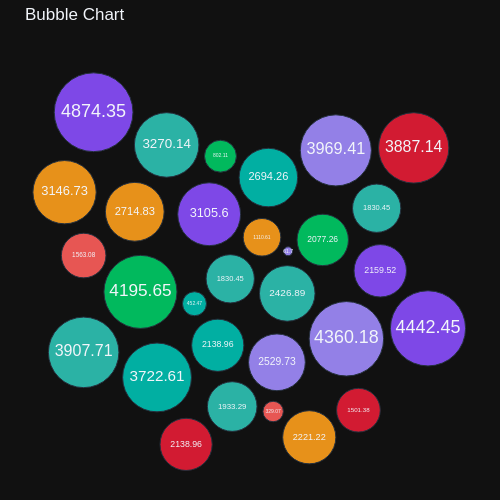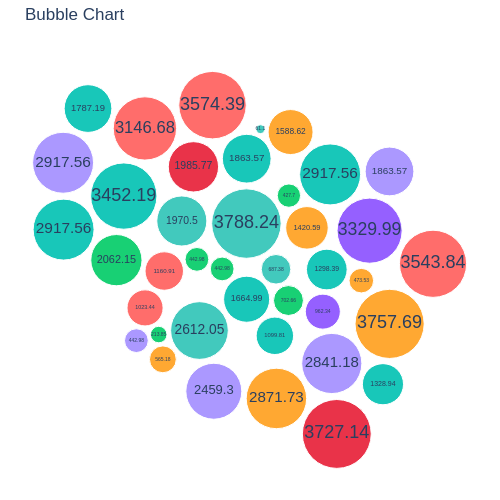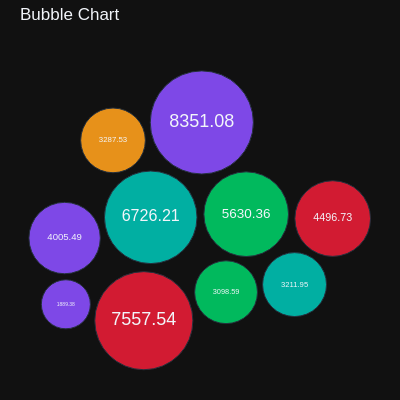This type of chart displays data using bubbles of varying sizes, arranged in a compact layout without overlaps, allowing for visual comparison of relative magnitudes within a limited space. Each bubble represents a category or entity, and its size is directly related to a quantitative value. I hope you find it useful.
import numpy as np
import pandas as pd
import plotly.graph_objects as go
class BubbleChartPlotly:
def __init__(self, labels, area, colors, bubble_spacing=10, plot_diameter=500):
self.labels = labels
self.colors = colors
self.area = np.asarray(area)
self.plot_diameter = plot_diameter
self.plot_radius = plot_diameter / 2.5
self.bubble_spacing = bubble_spacing
total_area = np.sum(self.area)
max_allowed_area = (np.pi * (self.plot_radius ** 2)) * 0.6
scale_factor = max_allowed_area / total_area
self.scaled_area = self.area * scale_factor
self.radii = np.sqrt(self.scaled_area / np.pi)
self.bubbles = np.ones((len(area), 4))
self.bubbles[:, 2] = self.radii
self.bubbles[:, 3] = self.scaled_area
self.maxstep = 2 * self.bubbles[:, 2].max() + self.bubble_spacing
self.step_dist = self.maxstep / 2
length = np.ceil(np.sqrt(len(self.bubbles)))
grid = np.arange(length) * self.maxstep
gx, gy = np.meshgrid(grid, grid)
self.bubbles[:, 0] = gx.flatten()[:len(self.bubbles)]
self.bubbles[:, 1] = gy.flatten()[:len(self.bubbles)]
self.com = self.center_of_mass()
def center_of_mass(self):
return np.average(self.bubbles[:, :2], axis=0, weights=self.bubbles[:, 3])
def center_distance(self, bubble, bubbles):
return np.hypot(bubble[0] - bubbles[:, 0], bubble[1] - bubbles[:, 1])
def outline_distance(self, bubble, bubbles):
return self.center_distance(bubble, bubbles) - bubble[2] - bubbles[:, 2] - self.bubble_spacing
def check_collisions(self, bubble, bubbles):
distance = self.outline_distance(bubble, bubbles)
return len(distance[distance < 0])
def collides_with(self, bubble, bubbles):
distance = self.outline_distance(bubble, bubbles)
return np.argmin(distance, keepdims=True)
def collapse(self, n_iterations=100):
for _ in range(n_iterations):
moves = 0
for i in range(len(self.bubbles)):
rest_bub = np.delete(self.bubbles, i, 0)
dir_vec = self.com - self.bubbles[i, :2]
norm = np.linalg.norm(dir_vec)
if norm == 0:
continue
dir_vec = dir_vec / norm
new_point = self.bubbles[i, :2] + dir_vec * self.step_dist
new_bubble = np.append(new_point, self.bubbles[i, 2:4])
if not self.check_collisions(new_bubble, rest_bub):
self.bubbles[i, :] = new_bubble
self.com = self.center_of_mass()
moves += 1
else:
for colliding in self.collides_with(new_bubble, rest_bub):
dir_vec = rest_bub[colliding, :2] - self.bubbles[i, :2]
norm = np.linalg.norm(dir_vec)
if norm == 0:
continue
dir_vec = dir_vec / norm
orth = np.array([dir_vec[1], -dir_vec[0]])
new_point1 = self.bubbles[i, :2] + orth * self.step_dist
new_point2 = self.bubbles[i, :2] - orth * self.step_dist
dist1 = self.center_distance(self.com, np.array([new_point1]))
dist2 = self.center_distance(self.com, np.array([new_point2]))
new_point = new_point1 if dist1 < dist2 else new_point2
new_bubble = np.append(new_point, self.bubbles[i, 2:4])
if not self.check_collisions(new_bubble, rest_bub):
self.bubbles[i, :] = new_bubble
self.com = self.center_of_mass()
if moves / len(self.bubbles) < 0.05:
self.step_dist /= 2
def to_dataframe(self):
return pd.DataFrame({
'x': self.bubbles[:, 0],
'y': self.bubbles[:, 1],
'radius': self.bubbles[:, 2],
'size': self.bubbles[:, 3],
'label': self.labels,
'color': self.colors
})
def plot_bubble_chart_plotly(df, plot_diameter=500):
chart = BubbleChartPlotly(
labels=df['label'],
area=df['size'],
colors=df['color'],
bubble_spacing=2,
plot_diameter=plot_diameter
)
chart.collapse()
df_bubbles = chart.to_dataframe()
df_bubbles['size_px'] = df_bubbles['radius'] * 2
fig = go.Figure()
fig.add_trace(go.Scatter(
x=df_bubbles['x'],
y=df_bubbles['y'],
mode='markers+text',
marker=dict(
size=df_bubbles['size_px'],
color=df_bubbles['color'],
sizemode='diameter',
opacity=0.9,
),
text=df_bubbles['size'].round(2).astype(str),
textposition='middle center',
textfont=dict(
size=np.clip(df_bubbles['size'] / df_bubbles['size'].max() * 20, 5, 18)
),
hovertemplate=(
'<b>%{customdata[0]}</b><br>' +
'Size: %{text}' +
'<extra></extra>'
),
customdata=df_bubbles[['label']],
))
fig.update_layout(
title='Bubble Chart',
template='plotly_dark',
xaxis=dict(visible=False),
yaxis=dict(visible=False),
margin=dict(l=0, r=0, t=40, b=0),
height=plot_diameter,
width=plot_diameter
)
fig.show()
n_bubbles = 40
colors = ['#00C1B2','#FF5E5B','#A28DFF','#2EC4B6','#E71D36','#FF9F1C','#8A4FFF','#00CC66' ]
df = pd.DataFrame({
'label': [f'Item {i}' for i in range(n_bubbles)],
'size': np.random.randint(2, 250, n_bubbles),
'color': np.random.choice(colors, n_bubbles)
})
plot_bubble_chart_plotly(df, plot_diameter=500)


